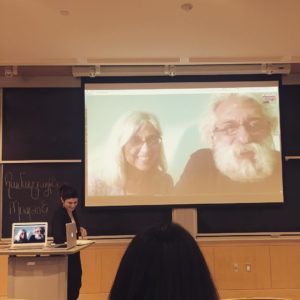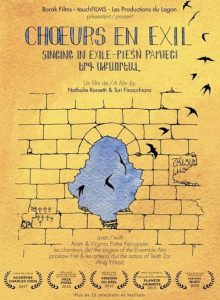CAMBRIDGE, Mass. (A.W.)—In collaboration with the MIT Armenian Society and the Armenian Weekly, the newly elected executive committee of the Hamazkayin Cultural and Educational Society of Boston screened the documentary film “Singing in Exile” (Nathalie Rossetti and Turi Finocchiaro, 2015) at the Massachusetts Institute of Technology (MIT) on April 19.

Laure Astourian, a film scholar and member of the Hamazkayin executive committee, introduced the film. The screening was followed by a dynamic question and answer session with the documentary subjects and founders of the Akn Ensemble, the musician and musicologist Aram Kerovpyan and the singer Virginia Pattie Kerovpyan.

“Singing in Exile” presents the fragile transmission of an ancient, critically endangered singing tradition. Through haunting chants and images of vacant landscapes and ruined churches, the documentary also evokes the legacy of the Armenian genocide. It is a pedagogical film on two levels: as viewers watch the Kerovpyans transmit chants and history to a group of European performers (Teatr Zar, a theatre company based at the Grotowski Institute in Wrocław, Poland), they are invited to learn from the process and also to reflect on its stakes—artistic, cultural, and historical.
The filmmakers Nathalie Rossetti and Turi Finocchiaro are Italians who live and work in Belgium. As a result, their documentary sheds light on the Armenian question and the Armenian genocide from a singular perspective: the film situates the event and its legacy in an Armenian context but also in a European context; in a modern-day Turkish context; and, of course, in relation to the question of artistic and cultural production and preservation. Many languages intermingle throughout the film: French and English as well as Armenian, Turkish, Kurdish, and Polish. Among the myriad shooting locations, Paris; Istanbul; Venice (which had a strong Armenian presence between the 15th and 18th centuries); the Kharpert region, Palu, Havav, and Dersim* in Eastern Anatolia; and Wrocław are all featured.

Perhaps one of the most valuable sequences in the film is that on Hrant Dink, the Armenian journalist who founded the bilingual Armenian-Turkish newspaper Agos and who was in 2007 assassinated in front of its office building. Footage of the resulting protests as well as an elucidating conversation between Aram Kerovpyan and his colleague Altuğ Yılmaz offer invaluable information and analysis that effectively contextualize the artistic work and mission of the Kerovpyans, Teatr Zar, and the directors of the film itself.

A recurring visual metaphor in the film is, as noted earlier, that of church ruins. Rossetti and Finnochiaro have—much like the subjects of their film—taken these shattered stones and created a lasting trace of their loss, a coherent and compelling archive for that which has been all but erased.
* The church featured on the film’s DVD cover is Yergayn Engouzents, in Dersim.


Be the first to comment